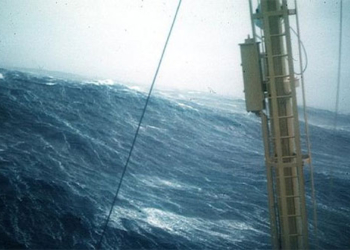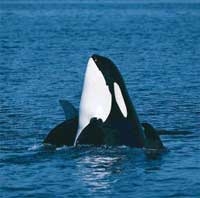A scientific device sank into the ocean, providing an opportunity for researchers to accurately calculate the depth of the Challenger Deep trench.
While aboard the R.V. Falkor in December 2014, David Barclay heard a sound through the headphones connected to the underwater microphone at the front of the ship. His mind conjured images of two scientific devices sinking into the water, falling into the Challenger Deep in the Pacific Ocean. This site is located nearly 11km below the waves, over 1.6km deeper than the height of Mount Everest, and is considered the deepest point in the ocean.
The two devices were part of Barclay’s research aimed at creating a lightweight and cost-effective method for recording underwater natural sounds, a project he had been pursuing since he was a graduate student at the Scripps Institution of Oceanography. Studying ocean sounds not only helps scientists understand ocean structure but also captures unique melodies from whales or submarines. The round trip of the duo of devices to record sounds inside the Challenger Deep was expected to last about 9 hours. However, when the time was up, only one device returned from the deep sea.

The Deep Sound Mark II device being submerged. (Photo: Dieter Bevans).
As Barclay later deduced, the popping sound came from the explosion of the glass housing protecting the device, a 38 cm sphere encasing the electronics. Despite the destruction of the device, Barclay and his colleagues found useful sounds from the noise of the collapse. The research team utilized acoustic waves reflected from the explosion, recorded by the surviving device, to perform one of the most accurate calculations of the Challenger Deep. Previous measurements mainly ranged from 10,900 to 10,950m, but the new estimate of the Challenger Deep’s depth is 10,983m.
For a long time, the scientific community has known that the Challenger Deep is the deepest point in the ocean, but it took them decades to determine the location and depth of this area. Barclay, now an associate professor at Dalhousie University in Nova Scotia, always meticulously prepares for each expedition. The night before each deployment of critical equipment, he compiles a list of potential mishaps. Listing possible failures helps Barclay avoid human errors like forgetting to charge batteries or turn on devices. However, there are always factors beyond Barclay’s control. Exploring the deepest places on Earth is not an easy task. The depth of kilometers creates extreme pressure. The pressure at the Challenger Deep reaches 1,260 kg/cm2, about 1,000 times the pressure at the water’s surface.
Only a few people have visited the Challenger Deep. The first were Swiss oceanographer Jacques Piccard and U.S. Navy Lieutenant Don Walsh, who used the research submersible Trieste on January 23, 1960. As the Trieste approached the ocean floor, the temperature dropped sharply, causing cracks in the organic glass window, creating a fissure along the cramped cabin. However, the window withstood the pressure, and Piccard and Walsh reached the Challenger Deep safely, staying for 20 minutes before surfacing.
Other scientists have sent various remotely operated vehicles to this trench or measured its depth from the surface using sonar. Barclay’s two devices were programmed to descend to a certain depth and remain there, recording the sounds of the ocean, before returning to the surface. One of the devices, named Deep Sound Mark II, was to dive to a depth of 9,000m. The other device, Deep Sound Mark III, was to reach the ocean floor. But when the duo of devices disappeared from sight, there were very few ways to track their journey.
Having prepared in advance, Barclay set up the underwater microphone on the ship to record sounds at the surface, listening for clues about what was happening below. That was when he heard the explosion. That afternoon, although unsure of what had happened, Barclay and his colleagues watched the surface of the sea at the scheduled time to retrieve the devices. They only found one device floating amid the waves. The scientists pulled Deep Sound Mark II aboard and listened to the recording. A series of noises echoed in the stillness, the noise from the underwater explosion of Mark III. Barclay speculated that one of the small ceramic pillars of the device might have failed, leading to the incident.
Due to the glass casing of Mark III shattering under the weight of 8km of water, the device released a pressure-vibrating gas pocket before bursting into tiny bubble-like membranes. The sounds from the entire process transmitted through the seawater, reaching the surface before echoing back into the deep sea, where Mark II was recording.
Measuring sound waves is one of the most common methods for mapping the ocean floor, similar to how bats use echolocation to navigate in the dark. For many years, researchers detonated explosives near the surface to generate sounds that would echo back to the ocean floor. Recently, they have shifted to controlled sound generation methods such as compressed air, according to Mark Rognstad, a seabed mapping expert at the Hawaii Institute of Geophysics and Planetology.
Rognstad noted that the shattering of the glass casing under pressure can be quite violent. The explosion of Mark III was powerful enough to cause sound waves to reverberate multiple times between the surface and the ocean floor. Based on the acoustic characteristics of the echoes, the research team determined the arrival time of the initial explosion and each subsequent echo. They then modeled the sound wave’s travel path, adjusting for changes in sound speed at different depths due to temperature, pressure, and salinity. This allowed them to calculate the depth of the Challenger Deep as 10,983m with a margin of error of about 6m.
Different methods yield different numbers for the depth of the Challenger Deep. As technology continues to advance, efforts to locate the deepest points of the ocean persist. An analysis published last year reported a depth of 10,935m from sonar and pressure data collected during multiple dives by explorer Victor Vescovo in the submersible Limiting Factor.
The explosion itself is an example of a serendipitous discovery, generating data that researchers collected unexpectedly. For the plan to listen to natural sounds in the Challenger Deep, Barclay and his team achieved their goal. In 2021, they deployed a device to the deepest point on the planet, recording the serene melody of the ocean for four hours.





















































